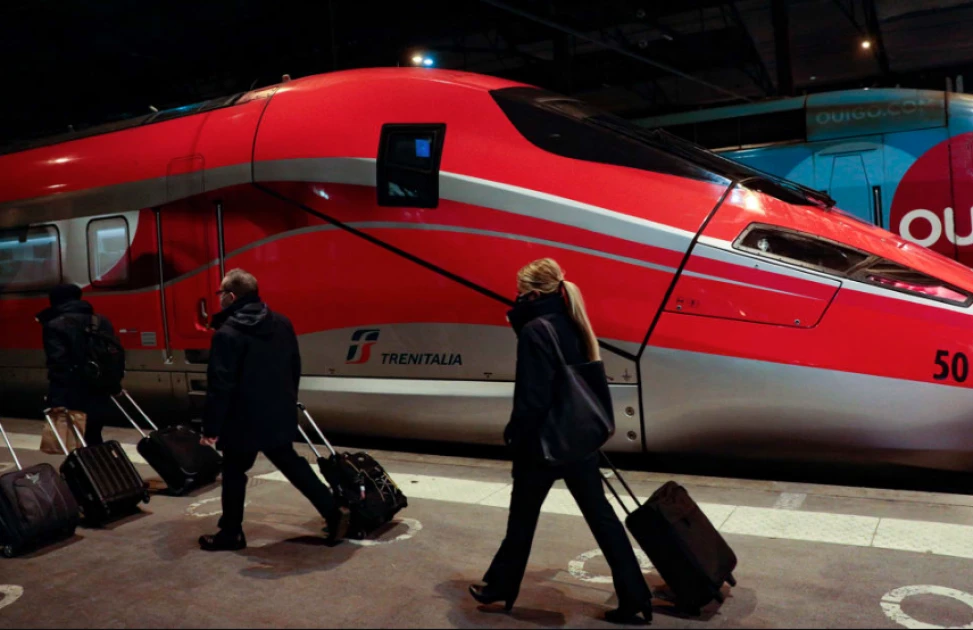Europe wants a high-speed rail network to replace airplanes

Breakfast
in Paris, lunch in Frankfurt and dinner in Vienna -- all without the hassle and
frustration of flying.
Imagine
a network of modern, super-fast and comfortable trains hurtling between every
major city in the European Union, providing a reliable, comfortable and
sustainable alternative to air travel.
That
was the vision outlined by rail industry leaders in Lyon, France, on June 29,
amid ambitious European plans to double high-speed rail use by 2030 and triple
current levels by 2050.
Only
a massive -- and accelerated -- expansion of the high-speed network can achieve
these hugely ambitious targets, but are they a realistic and affordable
proposition?
Unlike
many parts of the world, Europe already has thousands of kilometers of
dedicated high-speed railway.
France's
world-famous TGVs, Germany's ICE and Spain's AVE have transformed rail travel
over the last 40 years, but they remain largely focused on domestic markets.
That's
no surprise. When countries are investing billions of euros in new
infrastructure, political pressure to squeeze out the maximum benefit for
taxpayers is inevitable.
Building
lines across international borders, even within the European Union, creates
tension over who pays for what, how the contracts are allocated, conflicting
national standards and regulations and a host of other obstacles.
For
decades it's been too easy to kick difficult projects down the road until they
become someone else's problem.
Even
where international high-speed lines have been built -- often at enormous cost
-- national loyalties, stifling bureaucracy and high access charges are
preventing some routes from fulfilling their potential.
Others,
such as Paris-London via the Channel Tunnel and
Paris-Brussels-Amsterdam/Cologne are more successful but could -- and should --
be luring many more passengers away from short-haul air travel.
Now
a body of European organizations have committed to a new study highlighting the
numerous benefits of an expanded high-speed rail network connecting national
capitals and major cities.
These
include the European Commission, the Community of European Railways, the
European Rail Supply Industry and ALLRAIL, which represents non-state-owned
railways.
Most
importantly the group will investigate how to pay for tens of thousands of
kilometers of new lines and how a radical transformation of the continent's
rail network can help the EU deliver on its "Green Deal' objective of
carbon neutrality by 2050.
Some
of that expansion will come on new routes that are planned or under
construction but many more will be needed to facilitate the vision of European
leaders.
Alberto
Mazzola, executive director of the Community of European Railways told CNN
Travel the group wanted a "masterplan" showing the socio-economic
benefits of high-speed links between the continent's major cities.
"While
a lot has been achieved so far -- Paris-Lyon, Milan-Rome, Barcelona-Madrid and
Berlin-Munich are national success stories for rail -- much more is needed if
the ambitious objectives of the European Green Deal and Smart and Sustainable Mobility
Strategy are to be met," he said. "If we build
it, where should it go?"
And
that's where the first round of battles will be fought.
Reaching
an agreement on which routes to prioritize, which cities will benefit (and
which will miss out) will cause huge arguments between competing interests.
With
the shape of the final network likely to have a massive influence on the future
development of Europe and its cities over the next 100 years, cities will be
desperate to stake their claim.
While
some EU officials have hailed the proposals as the future of sustainable travel
in Europe, provided operators can make it efficient and cost-effective, others
have struck more cautious notes.
"Until
I see real concrete projects, rolling stock orders and timetables, I'll reserve
judgment," says Jon Worth, a campaigner for cross-border rail.
"Unfortunately
we've heard it all before and this sounds like the railways over-promising
again. Experience tells us that they can't deliver this kind of network in the
timescales they're suggesting."
Nevertheless,
France, Spain and Italy have well-established high-speed rail networks linking
their biggest cities, plus more lines planned or under construction.
More
than any other country to date, France has invested in new links with its
neighbors, building international routes to Belgium, the UK, Germany and Spain.
The
Lyon-Turin route now under construction, controversial because of environmental
impact and questions over financial probity, will add a fast link under the
Savoy Alps between France's second city and the industrial cities of northern
Italy.
Now
outside the European Union, the United Kingdom -- or more specifically London
-- remains plugged into the European network via the Channel Tunnel, but sadly
there will be no physical connection between its under-construction $118
billion (£88 billion) north-south High Speed 2 line and the existing London-Paris/Brussels routes used by Eurostar..
Sitting
in the center of Europe, sharing borders with nine other nations, Germany will
play a major role in any pan-European network. The German government's
"TEE2.0" proposal to reboot the old Trans-Europe Express is
an extension of its $88 billion "Deutschland Takt" (regular interval
timetable) program, announced in 2019, which aims to provide fast and frequent
inter-city rail services between all German towns and cities over a certain
size by 2030.
But
the biggest benefits could be felt elsewhere, in countries currently without
any high-speed railways. The Czech Republic is working with the French railway
industry to develop new 350 kilometers per hour (217 mph) lines that will
revolutionize journey times between Prague, Brno and Ostrava and deliver much
faster international links between Austria, Slovakia, southern Poland and
eastern Germany.
Poland
also plans to join the high-speed club with routes planned to radiate from
Warsaw to Lodz, Wroclaw and Poznan. Extensions towards Prague and Bratislava
are also planned in co-operation with its neighbors, although they are not
likely to materialize until the 2040s.
More
problematic are busy international routes that cross the Alps or the Pyrenees
-- natural barriers that have been a challenge to travelers for centuries.
A
good example is Munich in southern Germany to Milan in northern Italy. These
industrial powerhouses are less than 500 kilometers (300 miles) apart, closer
to each other than to their respective national capitals, but separated by the
Alps.
Slow
rail and road connections mean that airlines pick up most of this short-hop
inter-city business, but faster, direct trains could flip that share in rail's
favor.
When
it opens in 2032, the 64-kilometer-long Brenner Base Tunnel between Innsbruck,
Austria and Fortezza in Italy will cut around 70 minutes off existing
schedules.
According
to EU statistics, 17 of the 20 busiest air routes in Europe cover distances of
less than 434 miles (700 kilometers) -- exactly the kind of distances where
city center-to-city center trains can offer faster, cleaner and more
sustainable journeys -- if the right infrastructure exists.
A
Paris-Berlin flight generates at least six times the carbon dioxide emissions
of a similar train journey, according to a joint report from environmental
organizations in Germany, Poland, Spain and France. Flights of less than 621
miles (1,000 kilometers) between and within European countries are estimated to
create 28 million metric tonnes of CO2 every year.
And
according to Alberto Mazzola of the Community of European Railways, carbon
emissions trading could be a key tool in funding the massive investment
required to complete a Europe-wide high-speed rail network.
"The
EU's total CO2 emissions are around 3.8 billion tonnes every year -- transport
accounts for more than one billion tonnes of that. But if we reduce the current
carbon allowances for the aviation and road sectors the additional revenue
could be used to fund improvements to public transport."
Excess
carbon emissions from airliners, trucks and cars are currently charged at 50
euros per tonne in the EU, but this could soon rise to €80 per tonne. If just
10% of that revenue is re-invested in transport it could add around 8 billion
euros a year to the pot for rail upgrades.
"I
sense that there's a real positive willingness to invest in modal shift now,
but we need to move quickly," Mazzola adds.
Just
as important as civil engineering and sleek new trains, technologies such as
digital signaling, automatic train operation, big data and improved ticketing
will be critical to improving rail travel and attracting millions of new
passengers.
A
top priority for the Community of European Railways is the creation of an
independent ticketing platform by 2025, bringing together all available fares
and timetables across Europe.
By
2030 this information could be integrated with other transport modes, offering
travelers door-to-door information and fares for their journey, whether it's by
train, bus, bike or tram -- or a combination of modes.
This
level of integration is already standard in Austria and Switzerland and, to a
lesser extent, Germany, but elsewhere in Europe the quality of information is
patchy to say the least.
Despite
the best efforts of some governments and state-owned operators, competition on
high-speed routes is proving popular with passengers in Italy and Spain,
delivering improved services, higher frequencies and lower fares.
Organizations
such as ALLRAIL are pushing for similar reforms elsewhere in the EU, but
progress is frustratingly slow.
"We
want to see high-speed trains with 1,000 seats each connecting places around
Europe on a frequent basis," says Nick Brooks, secretary general of
ALLRAIL.
"This
will lead to low fares and high revenue. While other competing long-distance
transport modes are setting themselves 'net zero' emission targets, rail can do
it bigger and better. The outcomes of this study must enable high-speed rail to
become the backbone of long-distance travel in Europe."
Expanding
capacity by building high-speed railways creates more space on existing lines
for freight and regional/local trains.
When
main roads reached capacity after World War II, countries built highways and
autobahns. High-speed lines are the railway's equivalent of motorways, taking
the fastest long-distance traffic away and creating capacity on existing lines.
While
sleek high-speed trains steal the headlines and attract investment, many more
people will directly benefit from the modal shift possible through better local
and urban train services and transferring freight from roads to rail benefits
everyone.
However,
delivering such a wide-ranging, ambitious and costly package of new rail
projects across more than 20 countries with differing priorities and budgets is
fraught with difficulty, especially in times as uncertain as these.
Collectively,
it's estimated that European railways lost more than $52 billion during the
pandemic. Compensation from the EU and national governments has so far filled
only around one-fifth of that gigantic hole.
Equally
worrying is the estimated 20% drop in regular weekday commuter traffic, the
long-time backbone of railway revenue. Although long-distance and leisure
travel has recovered much more strongly, railway managers worry that cuts could
become inevitable if they don't close the gap.
The
sheer scale of the proposals also means that it will take many years to deliver
the necessary work, even if things go as planned.
Financial
support from emissions trading and the EU will doubtless help in many cases,
especially in Eastern and Central Europe, but it remains to be seen whether the
European Union can follow China's example in building a hugely ambitious
network of high-speed railways in such a short timescale.
Want to send us a story? SMS to 25170 or WhatsApp 0743570000 or Submit on Citizen Digital or email wananchi@royalmedia.co.ke
Comments
No comments yet.


Leave a Comment